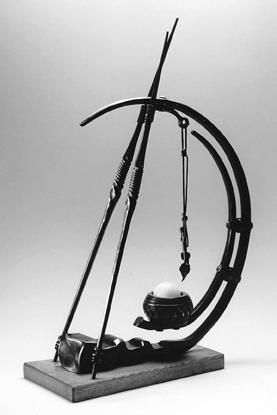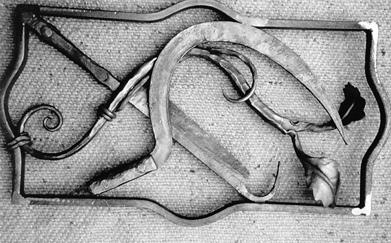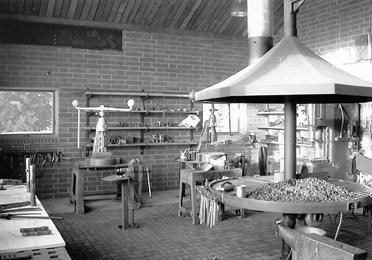| Note: Images with captions appear at the end of this
article.
Published in the April - May 2002 Issue of Anvil Magazine Creative forging combines traditional blacksmithing methods with modern artistry in the creation of artistic and inspired works. To date, the creative forging aspect has been a small part of the Calgary Stampede World Championship Blacksmiths Competition. Yet as the contest continues to grow, so does the artistic component. "People may think of wrought iron work as scrolls and bent metal, but this is so far removed from that," says Doug Newell, four-time winner of the Creative Forging Class (1998-2001). Newell moved to Canada from Great Britain in 1996. His background is in Agricultural Engineering, a subject he taught before becoming interested in forge work, which he studied at Hereford Technical College and the Hereford College of Art. "Everybody thought it was crazy," he says, explaining people's reaction to his decision to switch careers. But what drives me is the motivation to learn new things. This motivation led to starting his own business and working with some of the best artist blacksmiths in England. "I have them to thank for where I am at now," he says, noting the particular influence of Brian Russell and Jim Horrobin. "One option, instead of going to college, is to work with someone whose work you admire. I am interested in learning all the time, and since being here we have done six or seven classes at the Alberta College of Art and Design, including throwing pots and making jewelry." Newell's dedication to his craft was rewarded in the early 1990s when he was asked to do some work for the Tower of London. The new Jewel Room opened in 1994, and his work-which includes window grilles, gates and balustrades-sets off many of the priceless jewels of the British monarchy. He has also been a great admirer of the sculpture work of New York State's Albert Paley. In 2001, one of Newell's sculptures was used as an alumni fundraiser by Calgary Mount Royal College. The sculpture, with a musical theme, appears at the college's East Gate. Newell's decision to move to Canada came after he had spent time there on a temporary work visa. "I think it would be hard to go back to Britain," he says. "It now seems very crowded and expensive there." His experience competing in Calgary began in 1998. The competition had changed and there was a lot more money involved, he told us, explaining his decision to participate. The money continues to grow. This year's Creative Forging Class has a guaranteed purse of $5,000 overall, with $2,000 going to the Creative Forging Aggregate Champion. Prize money is also paid per phase, with first place receiving $400, second place $200, third place $160, fourth place $120, fifth place $70, and sixth place $50. For the first time in four years, Newell is not competing in Calgary. His decision to act as a judge in the 2002 and 2003 competitions is about giving something back and helping the competition grow. "My preference would still be to enter the competition, but it will be nice to go there on what could be the hottest day of the year and stay clean and stay cool." Newell understands the rigors of the Creative Forging Class. "You're working right down to the last few seconds," he explains, adding that there's no time to worry about the spectators. "I don't notice the crowd whatsoever." Although he participates in just the one class, contestants who wish to qualify for the World Championship must participate in all the farrier classes as well. It is four days of intense competition. "We're here to stay relaxed. Before the competition I have no stress, but for some of the farriers they are probably physically and mentally exhausted after four days," says Newell. Phase one of the Creative Forging Class remains the same for 2002, with competitors bringing in their pre-made pieces to be judged. The idea is to show what can be created when the competitor has unlimited time and resources. The piece must include a minimum of five of the following techniques: upsetting, flattening, bending, splitting, finishing, punching, drifting, twisting, and chiseling. A minimum of two of the following joining techniques must also be included: forge welding, riveting, collaring, wrapping, and mortise & tenon. The judges evaluate the work on creativity, quality & forging, effective use of material, and form to function. Last year's competitors submitted articles ranging from candle holders and tables to an elephant and a knife. (Newell's winning candle holder is pictured on the opposite page.) This year, phases two and three make up the live forging, with a time limit of one hour. In phase two, the contestants receive one 610 mm piece of 10x25 mm flat stock to build a flat, circular frame. This circle must be forge welded and have an outside diameter of 220 mm; all barstock must be used. The pieces will be judged on forge weld, quality of forging, and dimensions. In phase three, the competitors receive three pieces of metal with which to manufacture a creative design of their choice for the interior of the circular frame. It has to be attached to the circle either by forge welding or riveting, and five of the following techniques must be present: forge welding, upsetting, flattening, bending, splitting, drawing out, punching, drifting, twisting, and chiseling. In this year's competition, phases two and three contribute points to the World Championship. Whereas in previous years the creative forging was a one-man event, it is now a two-man class, allowing each team member to earn points. What do you do in your spare time if you're a World Championship Creative Forger? "Travel and blacksmithing-that's what I seem to do on vacations," says Newell. "I like to meet people." Newell has given workshops on a regular basis. In May of this year he is scheduled to do a Design Workshop and Demonstration near Kalispell, Montana, for the Northern Rockies Blacksmiths Association, and in 2003 he will be a demonstrator at the CanIron Conference in Hamilton, Ontario. At the CanIron Conference, he will be demonstrating air hammer use for making artistic ironwork. "The air hammer makes forge work less physically demanding and more of a mental challenge," he explains. Design work is Newells pet subject. "I see it more as an art form," he says of his work. "I don't shoe horses, but the guys who do can really do some good work, and they're used to making every heat and hammer blow count. "If I'm doing something I've got to do it really well. Competition isn't the `be all and end all.' I'm not competitive to the point that I believe first place is the only place to be; not at all." Newell says the difference between competing in Calgary and in Great Britain is about how the competitions work. In Britain competing is more frequent but much less structured, with numerous blacksmiths showing up and having an informal competition in someone's shop. "In Europe there are a lot more gates and railings and ironwork on houses," he says, explaining a difference in blacksmithing culture between the continents. How does he keep winning? "Being focused and having good designs is important. Two years ago the competition required a scroll panel as the test piece. I started out making it in 35 minutes and had to get it down to 30 minutes for the competition. By working out the sequence and practicing, I had it made easily in the time allowed." Newell sees himself as both a teacher and a designer, but more of a designer. "I feel quite strongly that the biggest part of learning is through doing. I like to play around with new ideas and techniques. You can't pass the vision on to someone else, but you can pass on the skills." |
|
| The World Championships' winning pre-made piece (Creative Forging) 2001: Mustad-the major sponsors of the entire event-bought this piece for $4,200 at the auction. They have purchased the winning piece at auction for the last four years. |
|
| Another example of Newell's work. |
|
| This piece was constructed with the help of an Australian art student at a day-long get-together in the UK. |
|
| Newell's workshop near Cochrane, Alberta. |
|
Return to the April - May 2002 Table of Contents Return to the Blacksmithing Articles Page
|
|



